Wangjun Jiang
Integrated Sensing and Communication Driven Digital Twin for Intelligent Machine Network
Feb 08, 2024



Abstract:Intelligent machines (IMs), including industrial machines, unmanned aerial vehicles (UAVs), and unmanned vehicles, etc., could perform effective cooperation in complex environment when they form IM network. The efficient environment sensing and communication are crucial for IM network, enabling the real-time and stable control of IMs. With the emergence of integrated sensing and communication (ISAC) technology, IM network is empowered with ubiquitous sensing capabilities, which is helpful in improving the efficiency of communication and sensing with the mutual benefit of them. However, the massive amount of sensing information brings challenges for the processing, storage and application of sensing information. In this article, ISAC driven digital twin (DT) is proposed for IM network, and the architecture and enabling technologies are revealed. ISAC driven DT structurally stores the sensing information, which is further applied to optimize communication, networking and control schemes of IMs, promoting the widespread applications of IMs.
Integrated Sensing and Communication enabled Multiple Base Stations Cooperative Sensing Towards 6G
Oct 11, 2023Abstract:Driven by the intelligent applications of sixth-generation (6G) mobile communication systems such as smart city and autonomous driving, which connect the physical and cyber space, the integrated sensing and communication (ISAC) brings a revolutionary change to the base stations (BSs) of 6G by integrating radar sensing and communication in the same hardware and wireless resource. However, with the requirements of long-range and accurate sensing in the applications of smart city and autonomous driving, the ISAC enabled single BS still has a limitation in the sensing range and accuracy. With the networked infrastructures of mobile communication systems, multi-BS cooperative sensing is a natural choice satisfying the requirement of long-range and accurate sensing. In this article, the framework of multi-BS cooperative sensing is proposed, breaking through the limitation of single-BS sensing. The enabling technologies, including unified ISAC performance metrics, ISAC signal design and optimization, interference management, cooperative sensing algorithms, are introduced in details. The performance evaluation results are provided to verify the effectiveness of multi-BS cooperative sensing schemes. With ISAC enabled multi-BS cooperative sensing (ISAC-MCS), the intelligent infrastructures connecting physical and cyber space can be established, ushering the era of 6G promoting the intelligence of everything.
* 11 pages 6 figures
Carrier Aggregation Enabled Integrated Sensing and Communication Signal Design and Processing
Sep 25, 2023



Abstract:The future mobile communication systems will support intelligent applications such as Internet of Vehicles (IoV) and Extended Reality (XR). Integrated Sensing and Communication (ISAC) is regarded as one of the key technologies satisfying the high data rate communication and highly accurate sensing for these intelligent applications in future mobile communication systems. With the explosive growth of wireless devices and services, the shortage of spectrum resources leads to the fragmentation of available frequency bands for ISAC systems, which degrades sensing performance. Facing the above challenges, this paper proposes a Carrier Aggregation (CA)-based ISAC signal aggregating high and low-frequency bands to improve the sensing performance, where the CA-based ISAC signal can use four different aggregated pilot structures for sensing. Then, an ISAC signal processing algorithm with Compressed Sensing (CS) is proposed and the Fast Iterative Shrinkage-Thresholding Algorithm (FISTA) is used to solve the reconfiguration convex optimization problem. Finally, the Cram'er-Rao Lower Bounds (CRLBs) are derived for the CA-based ISAC signal. Simulation results show that CA efficiently improves the accuracy of range and velocity estimation.
Symbol-level Integrated Sensing and Communication enabled Multiple Base Stations Cooperative Sensing
Aug 13, 2023Abstract:With the support of integrated sensing and communication (ISAC) technology, mobile communication system will integrate the function of wireless sensing, thereby facilitating new intelligent applications such as smart city and intelligent transportation. Due to the limited sensing accuracy and sensing range of single base station (BS), multi-BS cooperative sensing can be applied to realize high-accurate, long-range and continuous sensing, exploiting the specific advantages of large-scale networked mobile communication system. This paper proposes a cooperative sensing method suitable to mobile communication systems, which applies symbol-level sensing information fusion to estimate the location and velocity of target. With the demodulation symbols obtained from the echo signals of multiple BSs, the phase features contained in the demodulation symbols are used in the fusion procedure, which realizes cooperative sensing with the synchronization level of mobile communication system. Compared with the signal-level fusion in the area of distributed aperture coherence-synthetic radars, the requirement of synchronization is much lower. When signal-to-noise ratio (SNR) is -5 dB, it is evaluated that symbol-level multi-BS cooperative sensing effectively improves the accuracy of distance and velocity estimation of target. Compared with single-BS sensing, the accuracy of distance and velocity estimation is improved by 40% and 72%, respectively. Compared with data-level multi-BS cooperative sensing based on maximum likelihood (ML) estimation, the accuracy of location and velocity estimation is improved by 12% and 63%, respectively. This work may provide a guideline for the design of multi-BS cooperative sensing system to exploit the widely deployed networked mobile communication system.
SLAM for Multiple Extended Targets using 5G Signal
Aug 04, 2023



Abstract:5th Generation (5G) mobile communication systems operating at around 28 GHz have the potential to be applied to simultaneous localization and mapping (SLAM). Most existing 5G SLAM studies estimate environment as many point targets, instead of extended targets. In this paper, we focus on the performance analysis of 5G SLAM for multiple extended targets. To evaluate the mapping performance of multiple extended targets, a new mapping error metric, named extended targets generalized optimal sub-pattern assignment (ET-GOPSA), is proposed in this paper. Compared with the existing metrics, ET-GOPSA not only considers the accuracy error of target estimation, the cost of missing detection, the cost of false detection, but also the cost of matching the estimated point with the extended target. To evaluate the performance of 5G signal in SLAM, we analyze and simulate the mapping error of 5G signal sensing by ET-GOPSA. Simulation results show that, under the condition of SNR = 10 dB, 5G signal sensing can barely meet to meet the requirements of SLAM for multiple extended targets with the carrier frequency of 28 GHz, the bandwidth of 1.23 GHz, and the antenna size of 32.
ISAC-NET: Model-driven Deep Learning for Integrated Passive Sensing and Communication
Jul 14, 2023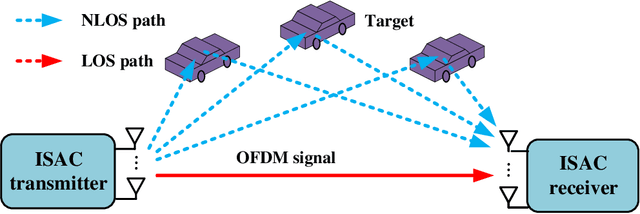
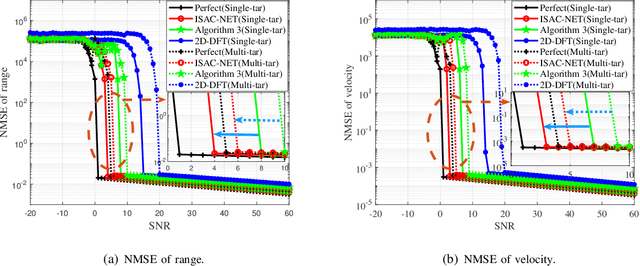
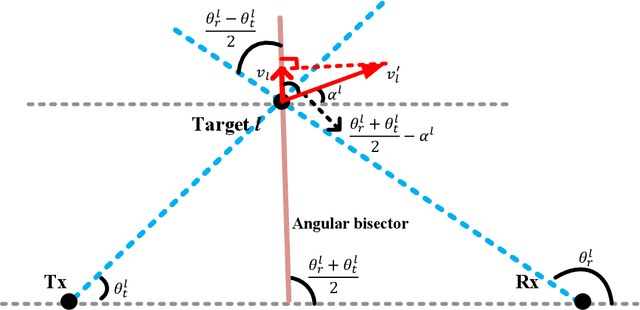
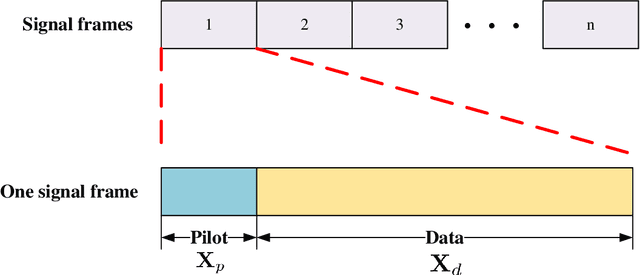
Abstract:Recent advances in wireless communication with the enormous demands of sensing ability have given rise to the integrated sensing and communication (ISAC) technology, among which passive sensing plays an important role. The main challenge of passive sensing is how to achieve high sensing performance in the condition of communication demodulation errors. In this paper, we propose an ISAC network (ISAC-NET) that combines passive sensing with communication signal detection by using model-driven deep learning (DL). Dissimilar to existing passive sensing algorithms that first demodulate the transmitted symbols and then obtain passive sensing results from the demodulated symbols, ISAC-NET obtains passive sensing results and communication demodulated symbols simultaneously. Different from the data-driven DL method, we adopt the block-by-block signal processing method that divides the ISAC-NET into the passive sensing module, signal detection module and channel reconstruction module. From the simulation results, ISAC-NET obtains better communication performance than the traditional signal demodulation algorithm, which is close to OAMP-Net2. Compared to the 2D-DFT algorithm, ISAC-NET demonstrates significantly enhanced sensing performance. In summary, ISAC-NET is a promising tool for passive sensing and communication in wireless communications.
Iterative Signal Processing for Integrated Sensing and Communication Systems
Jun 08, 2023Abstract:Integrated sensing and communication (ISAC), with sensing and communication sharing the same wireless resources and hardware, has the advantages of high spectrum efficiency and low hardware cost, which is regarded as one of the key technologies of the fifth generation advanced (5G-A) and sixth generation (6G) mobile communication systems. ISAC has the potential to be applied in the intelligent applications requiring both communication and high accurate sensing capabilities. The fundamental challenges of ISAC system are the ISAC signal design and ISAC signal processing. However, the existing ISAC signal has low anti-noise capability. And the existing ISAC signal processing algorithms have the disadvantages of quantization errors and high complexity, resulting in large energy consumption. In this paper, phase coding is applied in ISAC signal design to improve the anti-noise performance of ISAC signal. Then, the effect of phase coding method on improving the sensing accuracy is analyzed. In order to improve the sensing accuracy with low-complexity algorithm, the iterative ISAC signal processing methods are proposed. The proposed methods improve the sensing accuracy with low computational complexity, realizing energy efficient ISAC signal processing. Taking the scenarios of short distance and long distance sensing into account, the iterative two-dimensional (2D) fast Fourier transform (FFT) and iterative cyclic cross-correlation (CC) methods are proposed, respectively, realizing high sensing accuracy and low computational complexity. Finally, the feasibility of the proposed ISAC signal processing methods are verified by simulation results.
Toward Multiple Integrated Sensing and Communication Base Station Systems: Collaborative Precoding Design with Power Constraint
Jun 22, 2022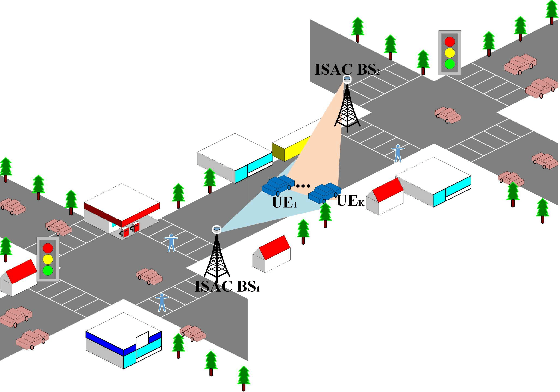
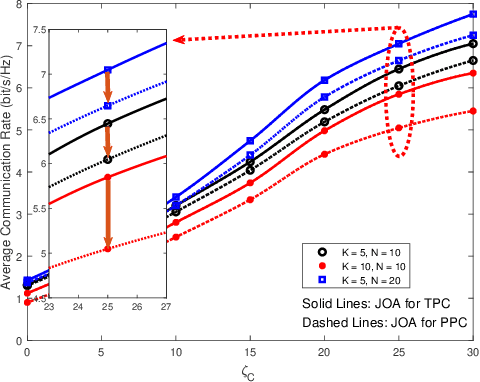
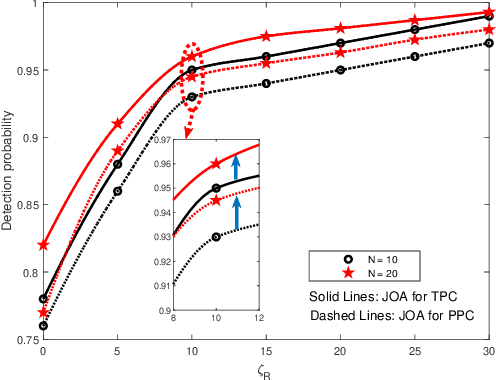
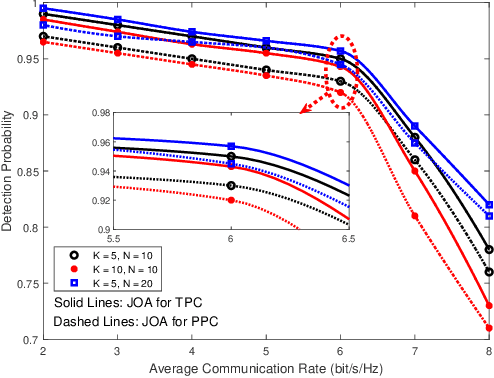
Abstract:The collaborative sensing of multiple Integrated sensing and communication (ISAC) base stations is one of the important technologies to achieve intelligent transportation. Interference elimination between ISAC base stations is the prerequisite for realizing collaborative sensing. In this paper, we focus on the mutual interference elimination problem in collaborative sensing of multiple ISAC base stations that can communicate and radar sense simultaneously by transmitting ISAC signals. We establish a mutual interference model of multiple ISAC base stations, which consists of communication and radar sensing related interference. Moreover, we propose a joint optimization algorithm (JOA) to solve the collaborative precoding problem with total power constraint (TPC) and perantenna power constraint (PPC). The optimal precoding design can be obtained by using JOA to set appropriate tradeoff coefficient between sensing and communication performance. The proposed collaborative precoding design algorithm is evaluated by considering sensing and communication performance via numerical results. The complexity of JOA for collaborative precoding under TPC and PPC is also compared and simulated in this paper.
 Add to Chrome
Add to Chrome Add to Firefox
Add to Firefox Add to Edge
Add to Edge